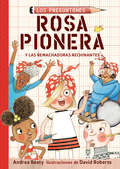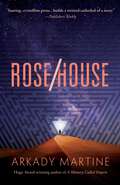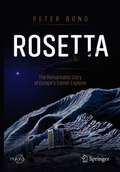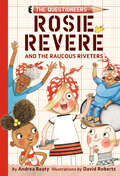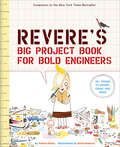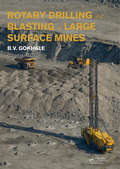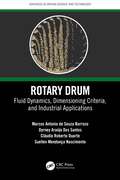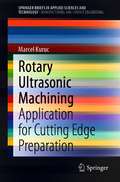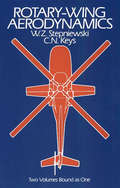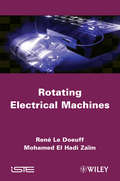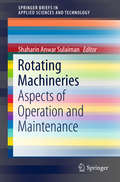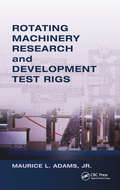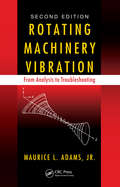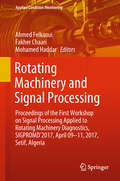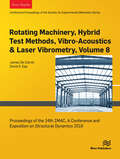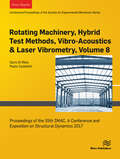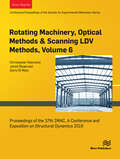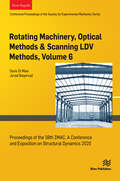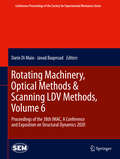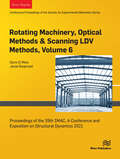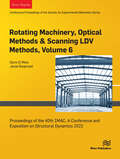- Table View
- List View
Rosa Pionera y las remachadoras rechinantes (Los Preguntones / The Questioneers Ser. #1)
by BEATY, ANDREA / ROBERTS,DAVID«¡Bestseller del New York Times! Continúan las aventuras de los Preguntones: Rosa Pionera, Ada Magnífica y Pedro Perfecto, ahora en una nueva serie de libros de capítulos cortos. La primera entrega, Rosa Pionera y las Remachadoras Rechinantes, es una historia enérgica sobre el poder del trabajo en equipo y el verdadero significado del hogar. Rosa Pionera conoce de fracasos, fallas, catástrofes y contratiempos. Después de todo, ¡la ingeniería tiene mucho que ver con la perseverancia! Pero esta vez, Rosa tiene un proyecto muy importante; uno que parece superior a sus posibilidades. Su querida tía-bisabuela Rosie y sus amigas, las Remachadoras Rechinantes, un grupo de divertidas mujeres que construyeron aviones durante la Segunda Guerra Mundial, necesitan ayuda para inventar algo nuevo. ¡Y Rosa es la ingeniera perfecta para la tarea! Después de un fracaso# luego otro# y otro más# Rosa comienza a perder la esperanza. Pero gracias a la ayuda de sus amigos Pedro Perfecto y Ada Magnífica, Rosa completa con éxito la misión. Y, junto con las Remachadoras, redescubre el significado del hogar.
Rose selvatiche siciliane: Caratteristiche biomorfologiche e fitochimiche, propagazione, coltivazione innovativa ed ecosostenibile, utilizzi e potenziali applicazioni
by Giancarlo Fascella Michele Massimo Mammano Adele Salamone Carlo GrecoLe Rose siciliane autoctone costituiscono una ricca fonte di biodiversità finora poco utilizzata (e conosciuta) ma che merita di essere adeguatamente valorizzata. In questa monografia vengono dettagliatamente descritte le quattro specie più presenti in Sicilia, riportando le principali attività sperimentali svolte e i risultati di maggior interesse realizzati dagli autori nell&’ambito di diversi Progetti di ricerca. Nei vari capitoli vengono in ordine descritti: i siti di reperimento e le caratteristiche botaniche delle specie individuate; i protocolli di moltiplicazione gamica (da seme) e vegetativa (da talea e da micropropagazione) per la loro produzione massale; le tecniche colturali per l&’allevamento a basso impatto ambientale e ridotto apporto di input delle rose siciliane; l&’analisi fitochimica dei falsi frutti (bacche o cinorrodi) e delle foglie, entrambi ricchissimi in biomolecole attive di interesse nutraceutico; la lavorazione e la trasformazione di alcune parti della pianta per l&’ottenimento di nuovi prodotti alimentari (conserve, dolci e liquori); la realizzazione di un integratore alimentare multivitaminico; l&’applicazione delle tecniche di agricoltura di precisione alla coltivazione di Rosa canina.
Rose/House
by Arkady MartineRose/House is a breathtaking and taut sci-fi gothic thriller from Arkady Martine, Hugo Award-winning author of A Memory Called Empire.“I’m a piece of architecture, Detective. How should I know how humans are like to die?”All of Basit Deniau’s houses were haunted. Rose House, his final architectural triumph built in the remote Mojave desert, was perhaps the most. A house embedded with an artificial intelligence is a common thing. But a house that is an artificial intelligence, infused in every crevice and corner with a thinking creature that is not human? That is something else altogether. That is Rose House. When Detective Maritza Smith gets a call from Rose House, she’s shocked to learn that there is a dead body behind its sealed-up door. Everybody in town knows it’s haunted. But Basit died more than a year ago, and everybody also knows that only his former protege, Dr. Selene Gisil, is permitted inside. But Selene wasn’t in the country when Rose House called in the death. Who is the dead body? How did they get in? And who—or what—killed them? The answers lie within the labyrinthine halls of Rose House. But even if Martiza can get inside, there is no guarantee she will ever be able to leave ...Also by Arkady Martine:A Memory Called EmpireA Desolation Called PeaceAt the Publisher's request, this title is being sold without Digital Rights Management Software (DRM) applied.
Rosetta: The Remarkable Story of Europe's Comet Explorer (Springer Praxis Books)
by Peter BondIn 2014, Rosetta became the first mission to orbit a comet and to deploy a lander onto its surface. This is the story of ESA’s pioneering comet explorer, following the mission from its initial inception to its historic touchdown. Read along as the Rosetta orbiter and its lander, Philae, evolve over the years, overcoming early mission hurdles before embarking on their one-way, decade-long voyage to a comet. See how the saga then culminates with Rosetta and Philae at last unveiling their icy target and achieving an unprecedented touchdown on its surface.Award-winning space writer Peter Bond takes us behind the scenes of this historic endeavor, sharing insights from the international team of scientists and engineers who made the mission possible, describing the remarkable technology that they created, and delving into the treasure trove of scientific discoveries that followed.Recounting in vivid detail the inner workings of Rosetta, this book is a celebration of the mission that has left a lasting impact on planetary science and space exploration.
Rosie Revere and the Raucous Riveters: The Questioneers Book #1 (The Questioneers)
by Andrea BeatyFrom the #1 New York Times bestselling team Andrea Beaty and David Roberts—who created Ada Twist, Scientist and Iggy Peck, Architect—comes Rosie Revere and the Raucous Riveters, a spirited story full of adventure, friendship, and science—and first in the Questioneers chapter book series. Watch Rosie Revere in the Netflix television series Ada Twist, Scientist! “Plenty of affection, creativity, and raucous older ladies to make readers smile.” ―Kirkus Reviews “[A] positive portrayal of diverse kids engaging in various arts and sciences.” ―Booklist Rosie Revere is no stranger to flops and fails, kerfuffles and catastrophes. After all, engineering is all about perseverance! But this time, Rosie has a really important project to tackle—one that feels much bigger than herself. Rosie’s beloved Aunt Rose and her friends, the Raucous Riveters—a group of fun-loving gals who built airplanes during World War II—need help inventing something new. And Rosie is just the engineer for the job! After one flop . . . then another . . . and another . . . Rosie starts to lose hope. But thanks to some help from her fellow Questioneers Iggy Peck and Ada Twist, Rosie gets the job done. And, along with the Riveters, Rosie rediscovers the meaning of home. Rosie Revere and the Raucous Riveters is the first in a unique and exciting series of chapter books for children, parents, and teachers who want to make STEM (science, technology, engineering, and math) fun. Check out all the books in the Questioneers Series: The Questioneers Picture Book Series: Iggy Peck, Architect | Rosie Revere, Engineer | Ada Twist, Scientist | Sofia Valdez, Future Prez | Aaron Slater, Illustrator | Lila Greer, Teacher of the YearThe Questioneers Chapter Book Series: Rosie Revere and the Raucous Riveters | Ada Twist and the Perilous Pants | Iggy Peck and the Mysterious Mansion | Sofia Valdez and the Vanishing Vote | Ada Twist and the Disappearing Dogs | Aaron Slater and the Sneaky SnakeQuestioneers: The Why Files Series: Exploring Flight! | All About Plants! | The Science of Baking | Bug Bonanza! | Rockin’ Robots!Questioneers: Ada Twist, Scientist Series: Ghost Busted | Show Me the Bunny | Ada Twist, Scientist: Brainstorm Book | 5-Minute Ada Twist, Scientist StoriesThe Questioneers Big Project Book Series: Iggy Peck’s Big Project Book for Amazing Architects | Rosie Revere’s Big Project Book for Bold Engineers | Ada Twist’s Big Project Book for Stellar Scientists | Sofia Valdez’s Big Project Book for Awesome Activists | Aaron Slater’s Big Project Book for Astonishing Artists
Rosie Revere's Big Project Book for Bold Engineers: 40+ Things to Invent, Draw, and Make (The Questioneers)
by Andrea BeatyWith more than 40 things to invent, draw, and make, featuring art from the beloved New York Times bestselling picture book Rosie Revere, Engineer, this activity book contains kid-friendly projects of all kinds and is the perfect gift for curious young readers! Soon enough children will be engineering whizzes just like Rosie, and along the way she’ll reassure them that failure, flops, mess-ups and cross-outs are part of the process. Do you like to make things? Dream up gadgets to improve your life and the lives of others? Then you are ready to join Rosie Revere and become a great engineer! Build a Solar Oven Make a Simple Catapult Design a Better Bicycle Collect “Engineer’s Treasure” And much more! Engineering is persevering, and this book is the perfect place for trying out, crossing out, and trying again. There is no better way to introduce would-be engineers to science and engineering than with their new best friend, Rosie. It’s fun for them and a great way for parents who want to get their kids excited about STEM (science, technology, engineering, math) in school. And now you can follow Rosie’s further adventures—with her friends Iggy Peck and Ada Twist—in the instant New York Times bestseller Rosie Revere and the Raucous Riveters, a chapter book starring The Questioneers! Don’t miss these STEM favorites! Rosie Revere, Engineer Iggy Peck, Architect Ada Twist, Scientist Iggy Peck’s Big Project Book for Amazing Architects Rosie Revere and the Raucous Riveters Ada Twist and the Perilous Pants Ada Twist’s Big Project Book for Stellar Scientists
Ross Sterling, Texan: A Memoir by the Founder of Humble Oil and Refining Company
by Ed Kilman Ross S. SterlingBorn on a farm near Anahuac, Texas, in 1875 and possessed of only a fourth-grade education, Ross Sterling was one of the most successful Texans of his generation. Driven by a relentless work ethic, he become a wealthy oilman, banker, newspaper publisher, and, from 1931 to 1933, one-term governor of Texas. Sterling was the principal founder of the Humble Oil and Refining Company, which eventually became the largest division of the ExxonMobil Corporation, as well as the owner of the Houston Post. <P><P> Eager to "preserve a narrative record of his life and deeds," Ross Sterling hired Ed Kilman, an old friend and editorial page editor of the Houston Post, to write his biography. Though the book was nearly finished before Sterling's death in 1949, it never found a publisher due to Kilman's florid writing style and overly hagiographic portrayal of Sterling.
Rotary Drilling and Blasting in Large Surface Mines
by Bhalchandra V. GokhaleIn large surface mining operations, drilling and blasting activities constitute more than 15% of the total costs. In order to optimize performance and minimize costs, a thorough knowledge of drill and blast operations is, therefore, extremely important.In this unique reference volume, rotary blasthole drilling and surface blasting, as applied in la
Rotary Drum: Fluid Dynamics, Dimensioning Criteria, and Industrial Applications (Advances in Drying Science and Technology)
by Marcos Antonio Barrozo Dyrney Araújo Dos Santos Cláudio Roberto Duarte Suellen Mendonça NascimentoRotary Drum: Fluid Dynamics, Dimensioning Criteria, and Industrial Applications provides in-depth analysis of fluid dynamics in rotary drums. In addition, it provides analysis on the different configurations, including nonconventional ones, diverse industrial applications, and comparison with competing dryer types, as well as the modeling of these devices. Covering important aspects of fluid dynamics in rotary drums, which directly influence the drying performance, the book also considers the significant cost of conventional rotary dryers. It takes into account the scale-up of rotary dryers and the control of product quality during processing, which can leave the final product overdried and overheated, wasting thermal energy. The book serves as a useful reference for researchers, graduate students, and engineers in the field of drying technology.
Rotary Ultrasonic Machining: Application for Cutting Edge Preparation (SpringerBriefs in Applied Sciences and Technology)
by Marcel KurucThis book covers the process and conditions of Rotary ultrasonic machining (RUM) of hard materials and summarizes the recommendation of proper machining parameters. The optimum conditions were applied for cutting edge preparation of CBN cutting inserts. The results presented in the book show that RUM is able to create controlled cutting edge preparation.
Rotary-Wing Aerodynamics
by W. Z. StepniewskiClear, concise text covers aerodynamic phenomena of the rotor and offers guidelines for helicopter performance evaluation. Originally prepared for NASA. Prefaces. New Indexes. 10 black-and-white photos. 537 figures.
Rotating Electrical Machines
by René Le Doeuff Mohamed El Hadi ZaïmIn this book a general matrix-based approach to modeling electrical machines is promulgated. The model uses instantaneous quantities for key variables and enables the user to easily take into account associations between rotating machines and static converters (such as in variable speed drives). General equations of electromechanical energy conversion are established early in the treatment of the topic and then applied to synchronous, induction and DC machines. The primary characteristics of these machines are established for steady state behavior as well as for variable speed scenarios. Important new applications for this technology (such as wind turbines, electric propulsion systems for large ships, etc.) are addressed and the book is illustrated with a large number of informative and detailed photographs, provided by various companies at the leading edge of research and applications in the field.
Rotating Machineries: Aspects of Operation and Maintenance (SpringerBriefs in Applied Sciences and Technology)
by Shaharin Anwar SulaimanThis book discusses the maintenance aspect of rotating machines, which it addresses through a collection of contributions. Sharing the “hands-on” views of experienced engineers on the aspect of maintenance for rotating machines, it offers a valuable reference guide for practicing engineers in the related industries, providing them a glimpse of some of the most common problems associated with rotating machines and equipment in the field, and helping them achieve maximum performance efficiency and high machine availability.
Rotating Machinery Research and Development Test Rigs
by Maurice L. AdamsRotating Machinery Research and Development Test Rigs presents the purpose and development processes for test apparatuses built for Research & Development in machinery technology and product development. Each R & D apparatus is the focus of an entire chapter, with fifteen detailed case studies included from mechanical, aerospace, chemical and biomedical engineering. Specific machinery components covered include bearings, seals, power plant pumps, rotors, turbines and compressors. Machinery condition monitoring and product development processes have been integrated. The specific purpose and results for each test rig are comprehensively presented and explained.
Rotating Machinery Vibration: From Analysis to Troubleshooting, Second Edition
by Maurice L. AdamsRotating Machinery Vibration provides engineering professions with a thorough grounding in relevant fundamentals. It describes sources and types of vibration and delves into computer modeling and machine vibration signal analysis. The book is accompanied by a disk filled with tools for analyzing general rotor vibration and rotor balancing. Providing detailed descriptions of vibration symptoms for rotor unbalance, dynamic instability, rotor-stator rubs, misalignment, loose parts, cracked shafts, and rub-induced thermal bows, this book is an essential reference for engineering professionals across design and manufacturing.
Rotating Machinery and Signal Processing: Proceedings of the First Workshop on Signal Processing Applied to Rotating Machinery Diagnostics, SIGPROMD’2017, April 09-11, 2017, Setif, Algeria (Applied Condition Monitoring #12)
by Fakher Chaari Mohamed Haddar Ahmed FelkaouiThis book provides readers with a timely snapshot of the potential offered by and challenges posed by signal processing methods in the field of machine diagnostics and condition monitoring. It gathers contributions to the first Workshop on Signal Processing Applied to Rotating Machinery Diagnostics, held in Setif, Algeria, on April 9-10, 2017, and organized by the Applied Precision Mechanics Laboratory (LMPA) at the Institute of Precision Mechanics, University of Setif, Algeria and the Laboratory of Mechanics, Modeling and Manufacturing (LA2MP) at the National School of Engineers of Sfax. The respective chapters highlight research conducted by the two laboratories on the following main topics: noise and vibration in machines; condition monitoring in non-stationary operations; vibro-acoustic diagnosis of machinery; signal processing and pattern recognition methods; monitoring and diagnostic systems; and dynamic modeling and fault detection.
Rotating Machinery, Hybrid Test Methods, Vibro-Acoustics & Laser Vibrometry, Volume 8
by James De Clerck David S. EppRotating Machinery, Hybrid Test Methods, Vibro-Acoustics & Laser Vibrometry, Volume 8. Proceedings of the 34th IMAC, A Conference and Exposition on Dynamics of Multiphysical Systems: From Active Materials to Vibroacoustics, 2016, the eighth volume of ten from the Conference brings together contributions to this important area of research and engineering. The collection presents early findings and case studies on fundamental and applied aspects of Structural Dynamics, including papers on: * Processing Modal Data * Rotating Machinery * Vibro Acoustics * Laser Vibrometry * Teaching Practices * Hybrid Testing * Reduced Order Modeling
Rotating Machinery, Hybrid Test Methods, Vibro-Acoustics & Laser Vibrometry, Volume 8: Proceedings of the 34th IMAC, A Conference and Exposition on Structural Dynamics 2016
by James De Clerck David S. EppRotating Machinery, Hybrid Test Methods, Vibro-Acoustics & Laser Vibrometry, Volume 8. Proceedings of the 34th IMAC, A Conference and Exposition on Dynamics of Multiphysical Systems: From Active Materials to Vibroacoustics, 2016, the eighth volume of ten from the Conference brings together contributions to this important area of research and engineering. The collection presents early findings and case studies on fundamental and applied aspects of Structural Dynamics, including papers on: Processing Modal Data Rotating Machinery Vibro Acoustics Laser Vibrometry Teaching Practices Hybrid Testing Reduced Order Modeling.
Rotating Machinery, Hybrid Test Methods, Vibro-Acoustics & Laser Vibrometry, Volume 8: Proceedings of the 35th IMAC, A Conference and Exposition on Structural Dynamics 2017
by Paolo Castellini Dario Di MaioRotating Machinery, Hybrid Testing, Vibro-Acoustics & Laser Vibrometry, Volume 8: Proceedings of the 35th IMAC, A Conference and Exposition on Structural Dynamics, 2017, the eighth volume of ten from the Conference brings together contributions to this important area of research and engineering. The collection presents early findings and case studies on fundamental and applied aspects of Rotating Machinery, Hybrid Testing, Vibro-Acoustics & Laser Vibrometry, including papers on: Rotating Machinery Vibro-Acoustics Experimental Techniques Advances in Wind Energy Scanning Laser Doppler Vibrometry Methods Hybrid Test Methods.
Rotating Machinery, Optical Methods & Scanning LDV Methods, Volume 6: Proceedings of the 37th IMAC, A Conference and Exposition on Structural Dynamics 2019
by Christopher Niezrecki Dario Di Maio Javad BaqersadRotating Machinery, Optical Methods & Scanning LDV Methods, Volume 6: Proceedings of the 37th IMAC, A Conference and Exposition on Structural Dynamics, 2019, the sixth volume of eight from the Conference brings together contributions to this important area of research and engineering. The collection presents early findings and case studies on fundamental and applied aspects of Structural Health Monitoring, including papers on: Novel Techniques Optical Methods Scanning LDV Methods Photogrammetry & DIC Rotating Machinery
Rotating Machinery, Optical Methods & Scanning LDV Methods, Volume 6: Proceedings of the 38th IMAC, A Conference and Exposition on Structural Dynamics 2020
by Dario Di Maio Javad BaqersadRotating Machinery, Optical Methods & Scanning LDV Methods, Volume 6: Proceedings of the 38th IMAC, A Conference and Exposition on Structural Dynamics, 2020, the sixth volume of eight from the Conference brings together contributions to this important area of research and engineering. The collection presents early findings and case studies on fundamental and applied aspects of Structural Health Monitoring, including papers on: Novel Techniques Optical Methods, Scanning LDV Methods Photogrammetry & DIC Rotating Machinery.
Rotating Machinery, Optical Methods & Scanning LDV Methods, Volume 6: Proceedings of the 38th IMAC, A Conference and Exposition on Structural Dynamics 2020 (Conference Proceedings of the Society for Experimental Mechanics Series)
by Dario Di Maio Javad BaqersadRotating Machinery, Optical Methods & Scanning LDV Methods, Volume 6: Proceedings of the 38th IMAC, A Conference and Exposition on Structural Dynamics, 2020, the sixth volume of eight from the Conference brings together contributions to this important area of research and engineering. The collection presents early findings and case studies on fundamental and applied aspects of Structural Health Monitoring, including papers on:Novel TechniquesOptical Methods,Scanning LDV MethodsPhotogrammetry & DICRotating Machinery
Rotating Machinery, Optical Methods & Scanning LDV Methods, Volume 6: Proceedings of the 39th IMAC, A Conference and Exposition on Structural Dynamics 2021
by Dario Di Maio Javad BaqersadRotating Machinery, Optical Methods & Scanning LDV Methods, Volume 6: Proceedings of the 39th IMAC, A Conference and Exposition on Structural Dynamics, 2021, the sixth volume of nine from the Conference brings together contributions to this important area of research and engineering. The collection presents early findings and case studies on fundamental and applied aspects of Structural Health Monitoring, including papers on: Novel Techniques Optical Methods Scanning LDV Methods Photogrammetry & DIC Rotating Machinery
Rotating Machinery, Optical Methods & Scanning LDV Methods, Volume 6: Proceedings of the 39th IMAC, A Conference and Exposition on Structural Dynamics 2021 (Conference Proceedings of the Society for Experimental Mechanics Series)
by Dario Di Maio Javad BaqersadRotating Machinery, Optical Methods & Scanning LDV Methods, Volume 6: Proceedings of the 39th IMAC, A Conference and Exposition on Structural Dynamics, 2021, the sixth volume of nine from the Conference brings together contributions to this important area of research and engineering. The collection presents early findings and case studies on fundamental and applied aspects of Structural Health Monitoring, including papers on:Novel TechniquesOptical Methods,Scanning LDV MethodsPhotogrammetry & DICRotating Machinery
Rotating Machinery, Optical Methods & Scanning LDV Methods, Volume 6: Proceedings of the 40th IMAC, A Conference and Exposition on Structural Dynamics 2022
by Dario Di Maio Javad BaqersadRotating Machinery, Optical Methods & Scanning LDV Methods, Volume 6: Proceedings of the 40th IMAC, A Conference and Exposition on Structural Dynamics, 2022, the sixth volume of nine from the Conference brings together contributions to this important area of research and engineering. The collection presents early findings and case studies on fundamental and applied aspects of Structural Health Monitoring, including papers on: Novel Techniques Optical Methods, Scanning LDV Methods Photogrammetry & DIC Rotating Machinery.
